welcome to my world
Ever wonder what happens to that blood sample you give that tells your doctor all the important numbers like cholesterol, HDL, iron and white blood cell count? If you've had a heart attack there might be a rise in the level of troponin in your blood. Bacterial infections can be diagnosed by growing the organism on an agar plate and then identifying the bug and determining what drug will treat it effectively. All of these things and many more are part of the diagnostic process known as clinical laboratory medicine. Laboratory tests, for the most part, are performed only on the order of a physician. Once the order is received, a specimen is obtained by a lab professional called a phlebotomist and transported to the testing area. Prior to testing the blood must be placed in a centrifuge which spins it until the blood is separated into plasma or serum component on top of the red cells. Most chemistry tests are performed on the "water" part of the blood, or plasma.
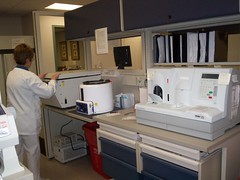
Following centrifugation, barcoded sample tubes are loaded onto an analyzer that reads the information contained on the barcode, including patient identification and tests to be performed.
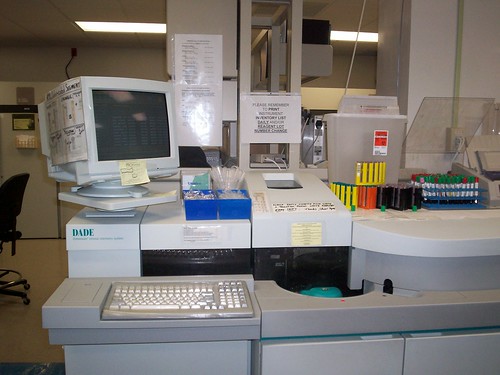
Some specimens require a whole blood analysis, such as the CBC or complete blood count that includes counts of the individual cells contained in the blood plus a differential on the types of white blood cells. If the instrument is unable to identify cells, the technologist must examine a blood smear under the microscope to identify them.
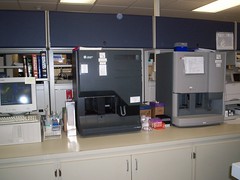
Specimens for bacterial culture are innoculated to agar plates like those pictured below. Identification depends on the type of agar preferred by different classes of bacteria in addition to the chemical reactions produced when they grow. Organisms are checked against different strengths of antibiotics to see which is the most effective treatment.
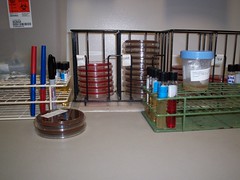
Blood isn't the only body fluid that aids in diagnosis. Technologists also perform analyses on urine, stool and other yucky stuff. Urine specimens are tested chemically, then examined under the microscope after centrifugation.
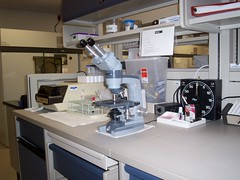
This is the area of the lab that is closest to my heart.....the transfusion service, aka blood bank. Five percent of the US population voluntarily donates their own blood so that patients who are in need will have human blood available. There is no viable substitute for human red blood cells when the body's supply is dangerously low. Blood donors have not been paid for years, due to safety concerns. It's all strictly volunteer. Imagine the logistics of managing a 5% commodity to supply the other 95%. It's mind boggling. Add to that the fact that you can't get just any old blood. It has to be a type that is compatible with yours, and it has to test compatible in pre-transfusion tests so that you don't have a reaction to it.
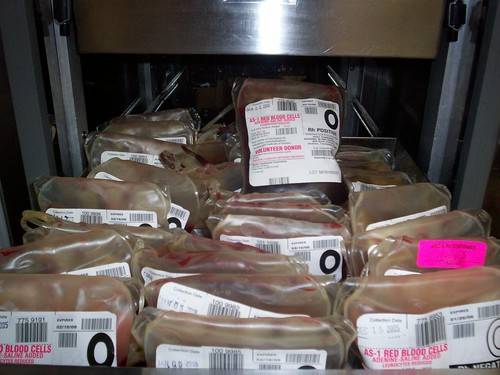
Presently there is a staggering shortage of medical laboratory personnel, which is projected to increase by leaps and bounds in the coming years.
That's only part of the scope of the laboratory. The anatomical lab includes the preparation and examination of tissue and cells by trained professionals to make diagnoses that range from a pap smear to a tumor. But we'll save that for another day.
Class dismissed. There WILL be a test.
^j^

Following centrifugation, barcoded sample tubes are loaded onto an analyzer that reads the information contained on the barcode, including patient identification and tests to be performed.

Some specimens require a whole blood analysis, such as the CBC or complete blood count that includes counts of the individual cells contained in the blood plus a differential on the types of white blood cells. If the instrument is unable to identify cells, the technologist must examine a blood smear under the microscope to identify them.

Specimens for bacterial culture are innoculated to agar plates like those pictured below. Identification depends on the type of agar preferred by different classes of bacteria in addition to the chemical reactions produced when they grow. Organisms are checked against different strengths of antibiotics to see which is the most effective treatment.

Blood isn't the only body fluid that aids in diagnosis. Technologists also perform analyses on urine, stool and other yucky stuff. Urine specimens are tested chemically, then examined under the microscope after centrifugation.

This is the area of the lab that is closest to my heart.....the transfusion service, aka blood bank. Five percent of the US population voluntarily donates their own blood so that patients who are in need will have human blood available. There is no viable substitute for human red blood cells when the body's supply is dangerously low. Blood donors have not been paid for years, due to safety concerns. It's all strictly volunteer. Imagine the logistics of managing a 5% commodity to supply the other 95%. It's mind boggling. Add to that the fact that you can't get just any old blood. It has to be a type that is compatible with yours, and it has to test compatible in pre-transfusion tests so that you don't have a reaction to it.

Presently there is a staggering shortage of medical laboratory personnel, which is projected to increase by leaps and bounds in the coming years.
That's only part of the scope of the laboratory. The anatomical lab includes the preparation and examination of tissue and cells by trained professionals to make diagnoses that range from a pap smear to a tumor. But we'll save that for another day.
Class dismissed. There WILL be a test.
^j^

 poopie :: Dyersburg, TN.
poopie :: Dyersburg, TN.


